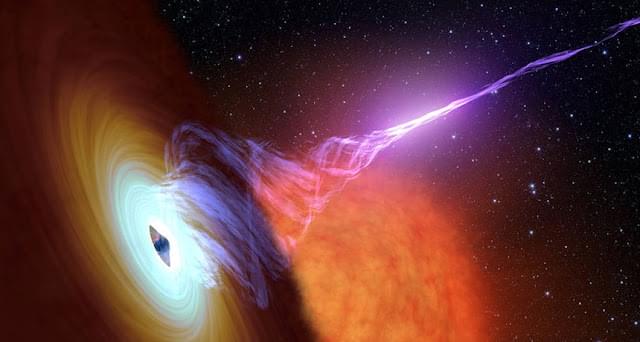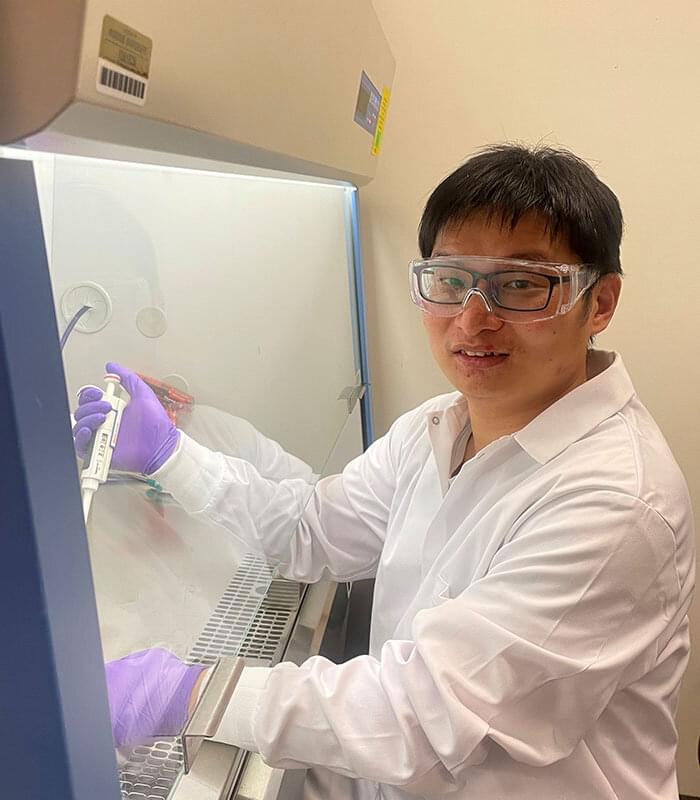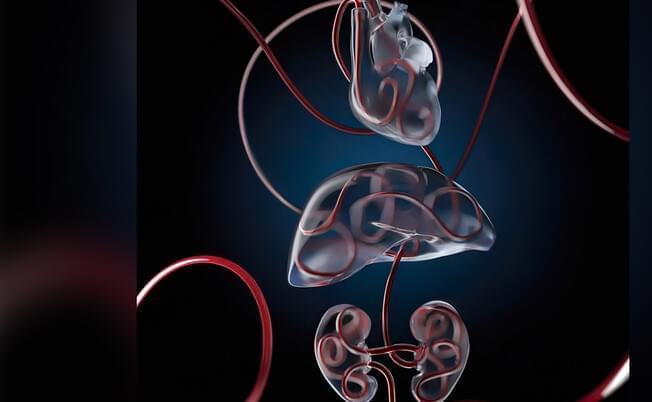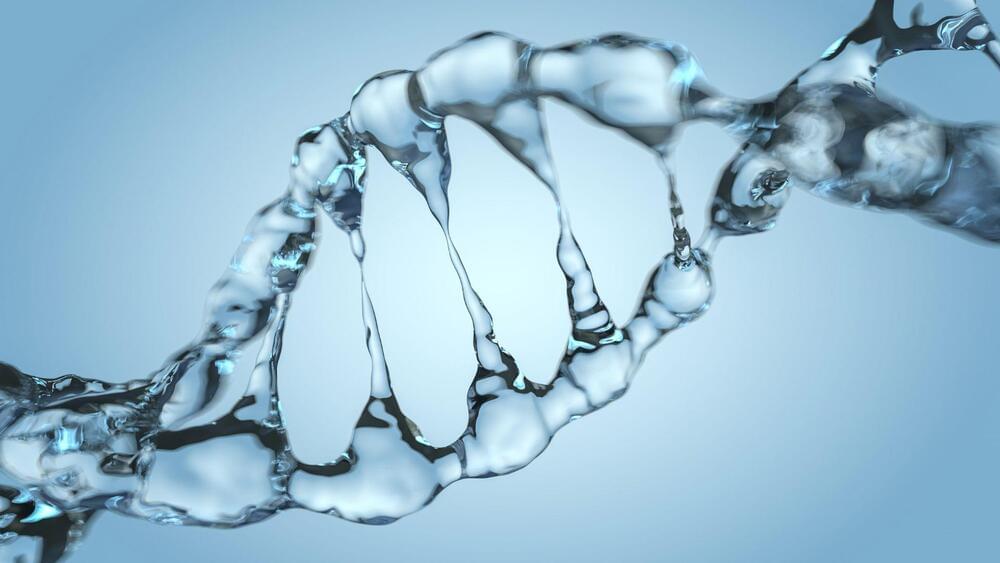
Category: chemistry – Page 288


Weird Energy Beam Just Left A Galaxy Travelling At Five Times the Speed of Light And Hubble Caught It
Science, Technology, Health, Physics, Chemistry stay Updated.
Scientists from The Australian National University (ANU) and James Cook University (JCU) have identified an “exquisite” natural mechanism that helps plants limit their water loss with little effect on carbon dioxide (CO2) intake—an essential process for photosynthesis, plant growth and crop yield.

Locusts can detect cancer in humans
A new study led by Michigan State University (MSU) has found that locusts can reliably detect through smell a variety of human cancers. The insects can not only “smell” the difference between healthy and cancerous cells, but they can also distinguish between different cancer cell lines. These findings could provide a basis for devices which use locust sensory neurons to enable the early detection of cancer by using only biomarkers in a patient’s breath.
“Noses are still state of the art,” said study senior author Debajit Saha, an assistant professor of Biomedical Engineering at MSU. “There’s really nothing like them when it comes to gas sensing. People have been working on ‘electronic noses’ for more than 15 years, but they’re still not close to achieving what biology can do seamlessly.”
Cancer cells function differently from healthy ones, and create different chemical compounds as they grow. If these chemicals reach the lungs or airways – which happens in most types of cancer – they can be detected in exhaled breath. “Theoretically, you could breathe into a device, and it would be able to detect and differentiate multiple cancer types and even which stage the disease is in. However, such a device isn’t yet close to being used in a clinical setting,” Professor Saha explained.

Neocortical pyramidal neurons with axons emerging from dendrites are frequent in non-primates, but rare in monkey and human
Archived histological material from tracing studies, immunohistochemistry, and Golgi impregnations allowed to discover a so far unrecognized structural difference, potentially of functional importance, between neocortical pyramidal neurons of rodent, carnivore, and ungulate as compared to monkey and man.
Engineers create world’s first carbon-neutral cement out of algae
The challenge: The building and construction sector is responsible for a big chunk of global carbon emissions. A lot of those emissions come from the production of cement, which is the second most consumed material on the planet behind water.
Cement produces emissions in two main ways. One is through the chemical reactions that occur while sintering limestone and other materials to make “clinker,” a key component of cement. The other comes from using fossil fuels to heat up kilns to very high temperatures.
Cement production releases massive amounts of carbon dioxide, other greenhouse gasses, and particulate emissions into the atmosphere. But it results in the world’s most widely used building material: concrete. Cheap, familiar, and reliable, concrete will likely remain the construction industry’s preferred material for years to come.

Graphene oxide membranes reveal unusual behaviour of water at the nanoscale
Do more pores in a sieve allow more liquid to flow through it? As material scientists have uncovered, this seemingly simple question may have an unexpected answer at the nanoscale—and it could have important implications in the development of water filtration, energy storage and hydrogen production.
Researchers from UNSW Sydney, University of Duisburg-Essen (Germany), GANIL (France) and Toyota Technological Institute (Japan) experimenting with Graphene Oxide (GO) membranes have discovered the opposite can occur at the nanoscopic level. The research, published in Nano Letters, shows the chemical environment of the sieve and the surface tension of the liquid play a surprisingly important role in permeability.
The researchers observed that a density of pores doesn’t necessarily lead to higher water permeability—in other words, having more tiny holes doesn’t always allow water to flow through at the nanoscale. The study, supported by the European Union and Humboldt Research Foundation funding, shines new light on the mechanisms that govern water flow through GO membranes.

New method mass-produces antitumor cells to treat blood diseases and cancer
A Purdue University chemical engineer has improved upon traditional methods to produce off-the-shelf human immune cells that show strong antitumor activity, according to a paper published in the peer-reviewed journal Cell Reports.
Xiaoping Bao, a Purdue University assistant professor from the Davidson School of Chemical Engineering, said CAR-neutrophils, or chimeric antigen receptor neutrophils, and engraftable HSCs, or hematopoietic stem cells, are effective types of therapies for blood diseases and cancer. Neutrophils are the most abundant white cell blood type and effectively cross physiological barriers to infiltrate solid tumors. HSCs are specific progenitor cells that will replenish all blood lineages, including neutrophils, throughout life.
“These cells are not readily available for broad clinical or research use because of the difficulty to expand ex vivo to a sufficient number required for infusion after isolation from donors,” Bao said. “Primary neutrophils especially are resistant to genetic modification and have a short half-life.”

Yale-developed technology restores cell, organ function in pigs after death
Within minutes of the final heartbeat, a cascade of biochemical events triggered by a lack of blood flow, oxygen, and nutrients begins to destroy a body’s cells and organs. But a team of Yale scientists has found that massive and permanent cellular failure doesn’t have to happen so quickly.
The researchers stressed that additional studies are necessary to understand the apparently restored motor functions in the animals, and that rigorous ethical review from other scientists and bioethicists is required.
The experimental protocols for the latest study were approved by Yale’s Institutional Animal Care and Use Committee and guided by an external advisory and ethics committee.
The OrganEx technology could eventually have several potential applications, the authors said. For instance, it could extend the life of organs in human patients and expand the availability of donor organs for transplant. It might also be able to help treat organs or tissue damaged by ischemia during heart attacks or strokes.

Researchers propose affordable and sustainable alternative to lithium-ion batteries
Concerns regarding scarcity, high prices, and safety regarding the long-term use of lithium-ion batteries has prompted a team of researchers from Rensselaer Polytechnic Institute to propose a greener, more efficient, and less expensive energy storage alternative.
In research published recently in Proceedings of the National Academy of Science (PNAS), corresponding author Nikhil Koratkar, the John A. Clark and Edward T. Crossan Professor of Engineering at Rensselaer, and his team, assert that calcium ions could be used as an alternative to lithium-ions in batteries because of its abundance and low cost.
“The vast majority of rechargeable battery products are based on lithium-ion technology, which is the gold standard in terms of performance,” said Dr. Koratkar. “However, the Achilles’ heel for lithium-ion technology is cost. Lithium is a limited resource on the planet, and its price has increased drastically in recent years. We are working on an inexpensive, abundant, safe, and sustainable battery chemistry that uses calcium ions in an aqueous, water-based electrolyte.”

An engineering breakthrough using DNA could unlock the quantum computing revolution
Scientists from the University of Virginia School of Medicine and collaborators used the building blocks of life to potentially revolutionize electronics.
The scientists utilized DNA to guide a chemical reaction that would overcome the barrier to Little’s superconductor, which was once thought to be “insurmountable”, a press statement reveals.